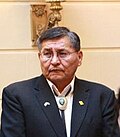| President of the Navajo Nation | |
|---|---|
| Diné Binantʼaʼí (Navajo) | |
 Great Seal of the Navajo Nation | |
| Residence | Window Rock, Arizona |
| Term length | Four years, renewable once |
| Constituting instrument | Navajo Nation Code & Treaty of 1868 |
| Inaugural holder | Peterson Zah |
| Formation | January 15, 1991 |
| Salary | $55,000.00 USD per year |
| Website | Office of the President and Vice President of the Navajo Nation |
The president of the Navajo Nation is the executive branch of the Navajo Nation. The office succeeded the tribal chairman, being created during the 1991 restructuring of the Navajo national government. The president and vice president are elected every four years. The Navajo Nation president shall serve no more than two consecutive terms. [1]
Contents
As outlined in the Navajo Nation Code §1001-1006, until 2016, office holders had to be fluent in the Navajo language among other declared qualifications. [2] Presently, fluency is to be determined by the Navajo voters when they cast ballots. [3]








